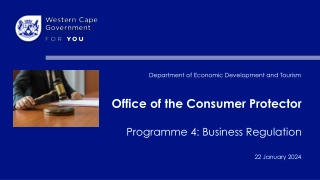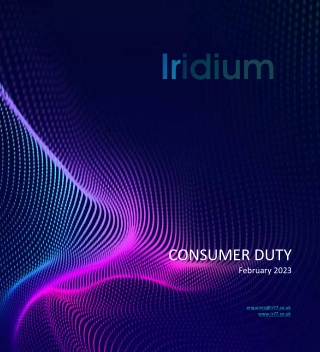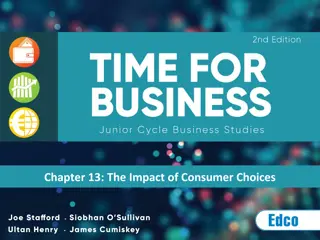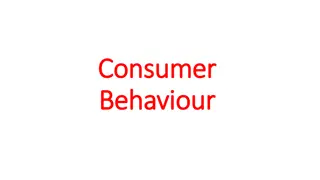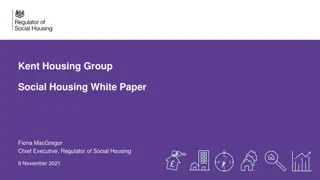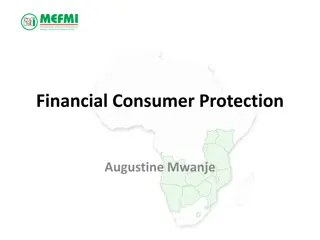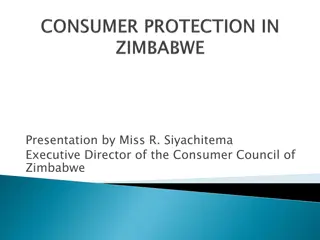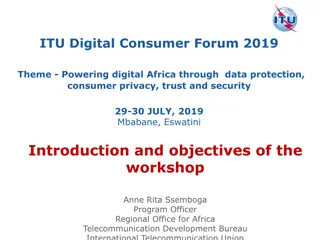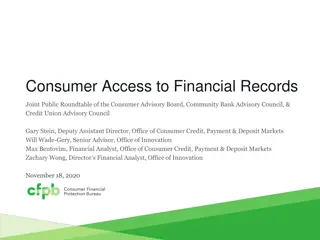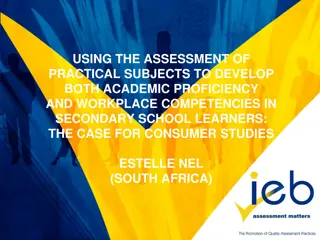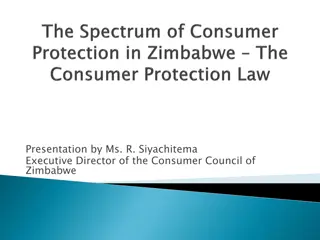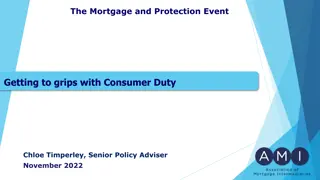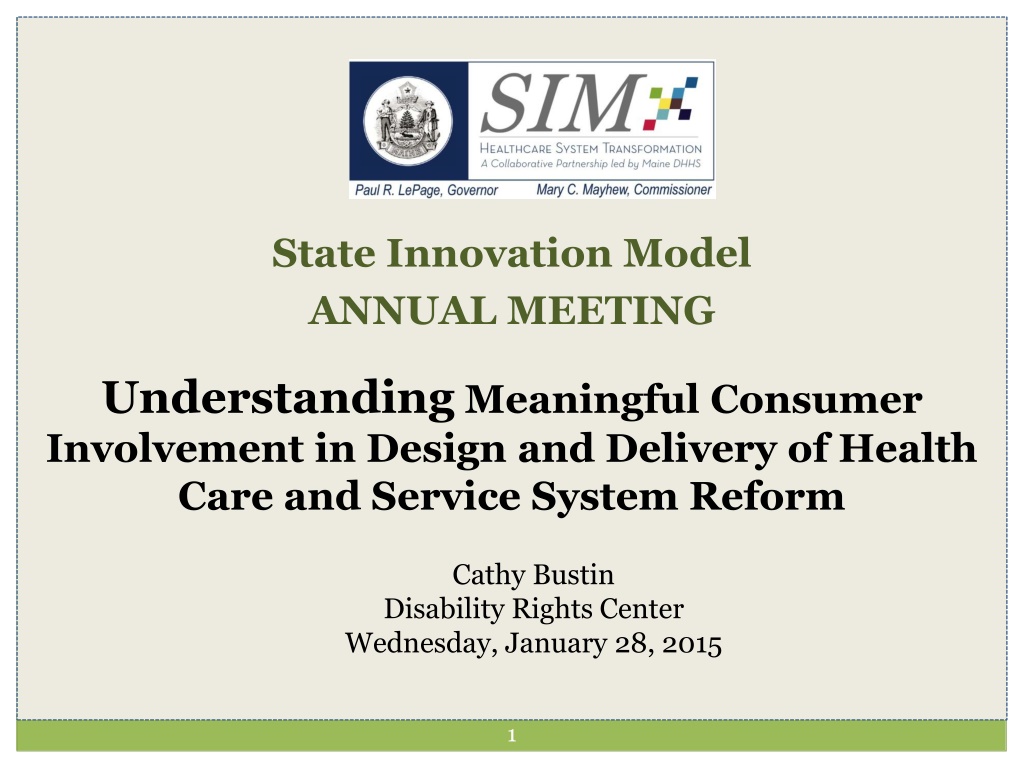
Meaningful Consumer Involvement in Health Care System Reform
This content highlights the importance of meaningful consumer involvement in the design and delivery of health care and service system reform. It emphasizes the need for experiential knowledge, multiple perspectives in decision-making, and active participation of service recipients and advocates at decision-making tables. Various barriers to full participation are addressed, focusing on changing attitudes and promoting individual engagement and relationships between patients and providers.
Download Presentation

Please find below an Image/Link to download the presentation.
The content on the website is provided AS IS for your information and personal use only. It may not be sold, licensed, or shared on other websites without obtaining consent from the author. Download presentation by click this link. If you encounter any issues during the download, it is possible that the publisher has removed the file from their server.
E N D
Presentation Transcript
State Innovation Model ANNUAL MEETING Understanding Meaningful Consumer Involvement in Design and Delivery of Health Care and Service System Reform Cathy Bustin Disability Rights Center Wednesday, January 28, 2015 1
2 Of all the barriers to full participation and inclusion, the barrier of unexamined attitudes is the most difficult to address - Ginny Thomburg Nothing About Us, Without Us Attitudes are the REAL disability - Paige Barton
Why Meaningful Consumer Involvement? Experiential knowledge brings unique Experiential knowledge brings unique perspectives Multiple perspectives are key to good decision-making All people deserve to participate in decisions that affect their lives Important to model relationships and decision-making that we ask of providers Increased opportunities for quality effective support service No one else can speak for us: We need to speak for No one else can speak for us: We need to speak for ourselves ourselves perspectives
You say Consumer Engagement? I say Consumer Involvement. Is it just semantics? NO 4
Patient/Consumer Engagement is 1:1 interaction between patient and or/family and provider. Engagement Tools Shared Decision-Making Individual/Person- Centered Plan Inclusion of Peer Specialists on Treatment Teams Trauma-Informed Approach 5
Consumer Engagement 6 Individual Patient and provider relationship and interaction ENGAGEMENT refers to an individual consumer/patient s level of active participation in their own treatment or service plan, and/or, their family s involvement
Meaningful Consumer Involvement= thepresence and full inclusion of substantial # of representatives of current and past service RECIPIENTS and their advocates at the decision-making tables at every level of the Systems Reform effort. Tools for Involvement Contact Impacted Consumer/Family Organizations and Advocates at Initiative Inception for Representative Recruitment All Policy Partners Participate in Monitoring Ongoing Involvement 7
Consumer Involvement 8 MEANINGFUL CONSUMER/FAMILY INVOLVEMENT refers to the SYSTEMIC INCLUSION of current or former service recipients/consumers, their families/parents and their designated organizations in the design, development, funding, delivery, and evaluation of health care services.
9 The value of Engagement and Involvement is similar: Increased Quality and Effectiveness of Services Increased Provider Understanding of What Helps and What Hurts Increased Consumer/Family Understanding of Health Care
Policy Partners 10 There is a need for consumers/families to be full policy partners in health care systems. Many consumer/family members are experiencing a loss of voice in systems designed to address their needs. This includes the SIM initiatives.
11 Inclusion is a mindset. It is not a program we run or a favor we do for someone. Oppression is the absence of choices. Bella Hooks
Can the SIMS effort ENGAGE with consumer/family organizations to Meaningfully Involve and benefit from their unique expertise? 12
YES! The SIMS grant has involved consumer/families. Here s how to make the involvement meaningful 13
Some Principles of Meaningful Consumer/Survivor/Recipient Involvement Darby Penney, a human rights activist, policy planner, and leader in the consumer movement has developed some key points on what meaningful consumer involvement and participation looks like 14
Meaningful consumer/survivor/recipient involvement is: Beyond tokenism: Sufficient numbers to have real influence and impact Beyond review and comment: involved in framing the issues and setting the agenda from the beginning Beyond advice: full participation in governance and policy-making Beyond sign-off: full partners in directing the outcome 15
Procedural Barriers frequently include: Insufficient information sharing Insufficient number of self-identified consumer/survivor/service recipients Lack of adequate notice of meetings Over use of jargon and bureaucratic language Lack of transportation 17
Structural barriers frequently include: Closed bureaucratic processes Agenda formed from provider perspective Lack of orientation for consumer/survivor/service recipients Lack of skill training, support, technical assistance 18
What to do? 19
Turning Barriers into Opportunities Address barriers with consumers: if day meetings are identified as a problem, schedule evening or weekend. Address transportation barriers by paying costs or ride sharing Offer reasonable accommodations in meeting structure such as breaks, access by phone, additional background materials 20
However, The most challenging Barriers can be Attitudes and Unexamined Bias Belief that consumers cannot understand complicated issues Professionals may personalize systemic feedback Consumers/Families may personalize meeting limits 21
Best vs Expressed Interest Shared Decision-Making Self-Determination Patient/Professional Partners SIMS SYSTEM REFORM CONTINUES DECADES OF WORK TO SHIFT SERVICE SYSTEM APPROACHES, BOTH INDIVIDUAL TREATMENT AND SYSTEMIC APPROACHES, FROM PASSIVE RECEIVING OF PROFESSIONAL EXPERTISE TO PERSON- CENTERED, EMPOWERED HEALTH CARE CHOICES 22
Suggestions for Addressing and Breaking Down Attitudinal Barriers 23
Encourage consumer/survivors to educate on values and history Structured dialogue on power differential Leaders/facilitators value consumer input and model this Ensure that consumers are at the table from the beginning 24
Make space open to challenging and discussing changing attitudes Reduce fear of challenging consumer participants or interrupting off-topic comments in the same way as with non-consumer participants Encourage efforts to hear and apply substantive feedback Use plain language 25
Avoid assumptions that negative feedback is not constructive Ensure that work products reflect input and feedback from consumers Support participation of consumers financially Avoid expecting that consumers speak with one voice 26
Some Other Strategies: Avoid handpicking consumer participants or asking only provider organizations for possible participants Reach out to peer organizations Acknowledge that one consumer does not represent all consumer experience/expertise Understand that consumers have a range of skills and experiences 27
Become culturally competent and design meetings/agendas in collaboration with consumers/families Allow adequate time for discussion and non- traditional/bureaucratic ways of conveying knowledge/expertise Provide orientation to the work at hand Pay attention to Person First Language Be aware of Power Differentials and Their Impact 28
Encourage diversity of expertise and experience Avoid assumptions that meaningful consumer involvement has happened because one event was held, one or two consumers are present, or a consumer advisory council, consumer forum gave input Take consumers/survivors seriously 29
Recommendations 30 How can SIM continue its efforts to involve consumers and families as full partners? 1. Seek to expand understanding of consumer / family experience of Meaningful Involvement/Inclusion 2. Include Consumer/Family Experts, local and national, in the Learning Collaborative and as consultants 3. Acknowledge and understand the power differential around the table 4. Appoint people on committee/advisory council, etc. to implement the recommendations
Recommendations 31 4. Create a glossary of frequently used acronyms and definitions of terms for easy reference 5. Create and distribute a comprehensive list of consumer/family/parent representatives on each committee, sub committee, council, project or initiative involved with the SIM grant efforts. Include names and contact information of organizations represented if applicable. 6. Create and distribute a list of all SIMS related activities and who to contact for involvement/information
Recommendations 32 7. Ask staff of all sub-committees to recruit mentors for new members or those seeking additional information regarding meeting subjects. 8. Recruit people to form a working group at the top of the SIM structure to guide and monitor continued efforts at achieving Meaningful consumer and Family Involvement throughout SIM reform work. Ensure that qualified representatives from all SIM partners are included, to expand ownership.
Recommendations 33 9. Endorse, support and continue expanded, comprehensive dialogue between all initiative partners. Build Relationships. Thank you for creating a space at the annual meeting. Partner with DHHS, providers, consumer/family organizations, and advocacy organizations, to create ongoing dialogue and discussion forums on achieving meaningful inclusion
34 Coming together is a beginning. Keeping together is progress. Working together is success. Henry Ford
A final thought from the presenter 35 I am your patient-partner when I am ENGAGED in health-care treatment with you. When I am sharing a systems change table with you and your peers, I am not a patient. I am INVOLVED as your POLICY PARTNER Language and Labeling Matters

